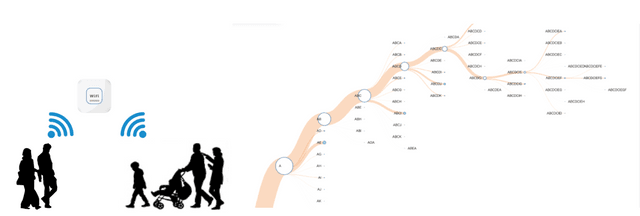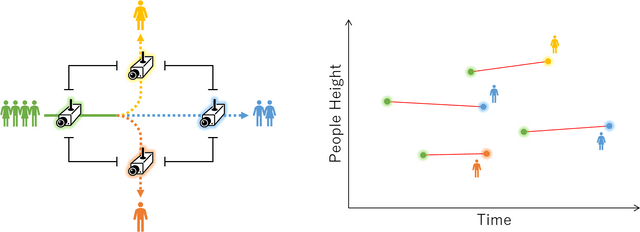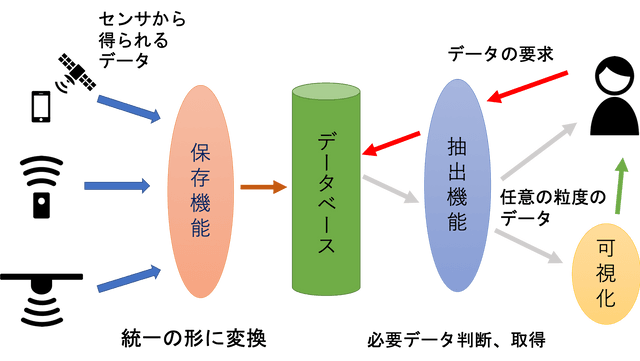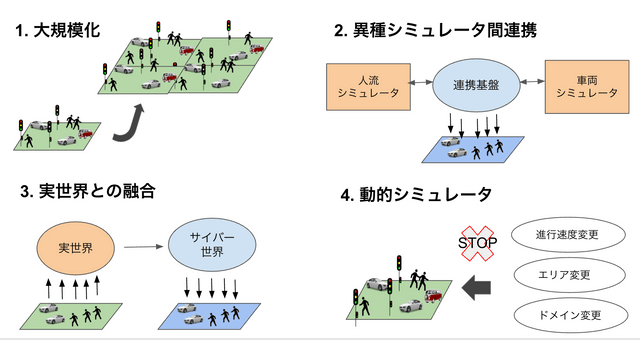Urban Computing
TOC
- Person-Flow Estimation using Wi-Fi Packet Sensors on Leisure facilities
- Privacy-Aware Person-Flow Estimation using 3D People Counters
- Unified System of Saving and Extracting Spatio-Temporal Data with Different Granularity and Formats
- Large-Scale Distributed Simulation Platform with a Multi-City-Level Area, Massive Amount of Mixed Domain Agents, and Dynamic Extensibility
Urban Computing Group conducts researches on wider area, for more efficient and comfortable life. Analysis targets are traffic-related data (bus operation records), people-flow-related data (GPS, Wi-Fi sensing, camera) and so on. This group also develops a distributed simulation platform with a multi-city-level area, massive amount of mixed domain agents, and dynamic extensibility.
Person-Flow Estimation using Wi-Fi Packet Sensors on Leisure facilities

In this study, we used Wi-Fi packet sensors installed at the Higashiyama Zoo and Botanical Garden to estimate the flow of visitors to the park. The MAC addresses included in Probe Requests sent from Wi-Fi devices such as smartphones and tablets are anonymized to create moving series data for each visitor. The moving series data is analyzed to estimate the degree of congestion and moving routes in the park. Using the estimated Person-Flow data, we aim to establish efficient facility management and various services for visitors.
Privacy-Aware Person-Flow Estimation using 3D People Counters

We are going to achieve Privacy-Aware Person-Flow Estimation by 3D People Counters installed at entrances of a target area. The data collected by 3D People Counters only include people height, walking speed, passing time and direction, and not include privacy information by GPS or Wi-Fi Sensing. Using height and walking speed similarity and duration between entrance and exit of all sensors, we estimate person-flow by extracting what is considered to be the movement of one person.
Unified System of Saving and Extracting Spatio-Temporal Data with Different Granularity and Formats

It is becoming possible to obtain a lot of Spatio-Temporal Data due to advances in mobile terminals and sensor technology. However, it has not been sufficiently studied to easily and uniformly handle data from heterogeneous sensors with different sample rates, resolutions, and formats. In this research, we create a system that can convert multiple types of sensor data with different spatio-temporal granularity into the spatio-temporal granularity desired by the user. The database can be divided into a database that can handle granularity-transformable data, a function to store data in a unified format, and a function to extract data at any granularity.
Large-Scale Distributed Simulation Platform with a Multi-City-Level Area, Massive Amount of Mixed Domain Agents, and Dynamic Extensibility

Simulation of human and traffic flow is used in a variety of fields, including urban planning, evacuation planning, and prediction and analysis of traffic congestion. In this research, we are developing a human traffic flow simulation platform that has four functions: large scale, heterogeneous inter-simulator collaboration, data assimilation, and dynamic extension. A distributed simulation model is employed to process each agent type and area. In addition, a variety of innovations are used to improve performance, such as the ability to distribute to multiple resources and the use of a flexible distributed system, Synerex.